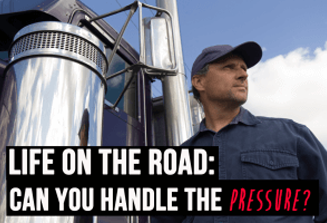CAREER TRAINING RESOURCES
Helpful Information About Potential Welding Careers & Trucking Jobs
Check out this selection of articles below to learn more about career choices and how to prepare for in-demand job opportunities.
-

Questions and Answers from the Trucking Community
Welcome to the Message Board. This page is a collection of messages posted by drivers in the trucking community, who have shared Questions and Answers on trucking forums across the internet. Updated regularly, please check back often. “Moving from driver to O/O [Owner/Operator] is more business sense than it is driver skill. Go talk to S.C.O.R.E or the local office listed at the bottom of this page. Microloan Program | The U.S. Small Business Administration | SBA.gov The folks in the "Participating Intermediary Microlenders Report" link They will work with you to help figure out how to get into a truck etc, write a business plan (it can be as simple as a napkin or more complicated). Financial statements etc. In short, they will give you a quick lesson in business management.” --User “mndriver,” offering advice (and reference links) to a driver with five years of Class A experience who is asking for advice on starting his own trucking company, at Truckers Forum.net.
“Read everything. Speed limits, restrictions, routing instructions, Bill of landings, owner’s manual to your truck, messages from dispatch, I mean everything…it’s usually al there somewhere.” --Oldman49, responding to a user requesting advice on making their trucking career as smooth as possible, on a thread at The Truckers Report.
“1. Keep paper towels on the truck 2. Keep wet wipes on the truck 3. Keep some canned food on the truck 4. Keep some water / soft drinks on the truck 5. On hot days offer water/soft drinks to the guards or unloader/loader. You may get better treatment (especially if you have their favorite.) 6. Expect everyone in front of you to do something stupid and plan accordingly. 7. Don't be lax in your duty, but don't stress either 8. Promptly get your paperwork in 9. Present a professional image to the customer (you represent your company.) 10. Practice trip planning every day.” --Forum user “Salad,” in response to the thread “Any tips for a new driver?” on The Truckers Report,
“I want to be a trucker driver because..... It's time for me to do something I've always wanted to do. I've worked good jobs that I hated for all of my married life. It served me and my family well, and I was happy to do it, and have always been proud of the life my wife and kids enjoyed because I worked hard, even if I didn't like the work. But I've always wanted to drive long haul OTR, it's just that married life and two beautiful children sort of put that choice on hold. But those responsibilities have ended and now I can work at something that I think will suite [sic] me well. I enjoy the solitude of the road, while I wouldn't say I'm loner. I've always strived to have a minimal lifestyle. For me simple was always better. I'm going to enjoy not being in the same place every day, even if it looks the same (if you've seen 1 truck stop....) --User “BeanDip,” responding to a thread asking “Why do you want to be a truck driver?”
“You are going to need a year of driving, to just adapt to the lifestyle. Also, to develop your driving skills, and work relationship with your dispatcher, and learning how your company does business. None of this comes quickly, and your attitude is being closely watched. Remember...you are responsible for much of the business success or failure. Tremendous amount of money goes into that rig, freight, and contract with the client....and you are the backbone of it all.” User “Roadhog,” in a thread titled “The Driver and The Employer, Basic Job Hunting Skills,” on the Class A Drivers Message Board.
“Hello guys its been a week since I graduated cdl school, and I have already been offered a job…with a local milk delivery company driving Class B trucks (I have my Class A). I start tomorrow morning. For all the people asking if it’s possible to find a local job with no experience its possible you just have to put in some work. I…found out these companies’ contact information and office location and either called or just showed up with a simple resume and told them I’m looking for a Class A or B driving position and was straightforward about being straight outta CDL school (with) no experience I…went to a CDL staffing agency, where I was told that I would need at least a year experience and no one would hire me local I would need to go OTR. If you want a local job without experience, go out there and get it. Don’t just call or put an application in online, go down to the company and tell ‘em you want to work for them (they love this kind of initiative). Bring a resume with you, bring a copy of your driving abstract cdl & medical card.” --User “RedTheTrucker,” on the post “How to Find a Local Job with No Experience??” at The Truckers Report.
“Holding a CDL has made me a substantially better driver. Its corrected a lot of bad habits I never realized I had. I've acquired a lot of patience and no longer feel the need to speed in my car... I no longer feel the need to tailgate... I've garnered a great deal of tolerance for traffic... I love having the ability to decipher when a car or truck is about to do something stupid. I also read every single sign on the road now out of habit. My CDL has turned me from a decent driver to a professional driver.” --User “KiLLaZiLLa93,” responding to the question “Has your CDL made you a better driver?” on The Truckers Report.
“If it were me, would stay there another 6 months. Looks better on your home loan application also that you’re not a job hopper.” --User Chinatown, in response to a user who asked for advice on leaving his first trucking job six months after earning his CDL, at The Truckers Report. -

Important Things to Ask in Your Next Trucking Interview
There are few tasks as potentially uncomfortable as a job interview, especially a trucking interview. You’re under the microscope, being needled by one or more members of a company you may or may not be desperate to work for. For truck drivers looking for their first jobs, it can be even more harrowing and confusing. And while many applicants are bracing themselves for the questions they are going to have to answer, many forget to do the reverse, which is equally important to getting the job and to taking some semblance of command of your job search: what questions should you be asking? Most of us, especially those of us who are younger, can easily forget that the questions we ask say just as much about us as the ones we answer. Many employers gain more information from that portion of the interview than the part when we are answering questions. And why not? It is revealing about you which questions you ask. It demonstrates what is important to you as an employee and a person. If you lead with “how much does this position pay?” chances are you are going to be looked at as a money chaser, not a potentially valued employee. You need to be measured in your responses and ask pointed, important questions about the nature of your work. Here are some questions you should be posing to the companies interviewing you: What is your policy on home time? When you’re an over-the-road driver, you’re going to be spending a lot of time away from home. It’s only fair for you to know how long you will be home in between. Also, be sure to get a clarification on defining “a day”; for instance, if you are promised two days of home time after a week-long trip, is that two full days, or the remainder of the day after you return to the terminal, then one day after? Some companies will not offer to tell you this information. Which routes will I be driving? You want to know what your typical routes will look like. This is a common question to ask, and you should be immensely curious about it. You may want to ask this question first. Am I unloading my own truck in this job? Some companies pay the drivers to load and unload your freight, while others pay people known as “lumpers” to do it for you. Whether or not you are able or willing to do this part of the job is pretty important, and you should know going in whether you’re doing the heavy lifting, or if others are doing it for you. Will I get a driver manager? For younger drivers, a driver manager can help you adapt to the trucking industry and establish a good relationship with the company. With the ability to answer your questions and offer you training and advice, a driver manager can help you become promoted more quickly, as well as help you handle any issues or concerns you may have. What type of equipment does the company use? Again, another important question that both answers a question about your potential comfort and productivity, and about the company itself. Are the trucks old? If so, they may be perpetually breaking down and harming your ability to be productive. If they continually spend on new equipment, that may be a good sign. Also, will you have a sleeper on the truck? Will you have an air-ride suspension? When you’re sitting in the truck all day, these are potentially important questions. Does the company have a slip-seat policy? “Slip-seat” means that when a driver has time off, another driver may take his place driving his route. That means another driver behind the wheel of your truck, which can make some drivers uncomfortable. It’s better to know whether you will be subject to this before you begin. How much does the company pay? Yes, it’s a question you should ask, even if you shouldn’t ask it first. Ask all of the questions about the job first, then lead into the question of pay. Compare it to average driver pay scales and see where they rank. While you want to be delicate question to ask, it is important to remember that you are a professional and pay should be on your mind at some point. Don’t forget to get information on any bonuses you may receive as well. What benefits does the company offer? Medical insurance, time off, home time, disability coverage, 401(k) matching; these are all important factors in whether you should accept a job or continue looking for a new one. To be certain, as a job prospect you are putting yourself in a position to be asking for a job. But don’t discount what you bring to the table in this relationship, and the fact that you will be serving this company every day of your working life while you’re employed there. Be sure you are showing respect to the company, but also demand it in return. A good, solid professional attitude will go a long way in getting you a job. -

Discover the Biggest Struggle Truck Drivers Face
Ask most any driver about the biggest source of stress for truckers, and invariably the answer will be “time away from home.” And indeed it is an eternal source of consternation for many a truck driver, and is chief among reasons why this isn’t a profession fit for just anyone. However, if you are reading this, chances are fair that you are already expecting this part of the job, and you fall somewhere between embracing this part of the job and tolerating it for the sake of a paycheck. But once you are out on the road, buddy, it’s a whole new ballgame. It’s one thing to be a single person, a young man or woman, ready to make your way out onto the open road, just you and your rig and the load you’re carrying, but once you’re out there and reality sets in that you’re out here alone, your thinking can change really quickly. Of course, when you’re on the road and working, concentrating on your electronic logs and on paying attention to the road and keeping the truck in the proper lane, you may not be thinking too much of what you are missing at home. It’s the time when you aren’t driving, when you’re hunkered down in a truck stop, waiting in line to take a shower or nestled in your tiny bunk in the back of your truck that reality sets in. Do you have a special someone at home? Be sure they can handle the pressure too. Many a driver had his career, or marriage, derailed by a significant other who grew weary of the solitude that many young truckers crave. Remember that when you have a family, truck time doesn’t only affect you; it takes hold of everyone in your family. Going over the road can indeed be tough. If driving a truck takes a special breed of person, going over the road can take a saint. Recognize what it is you’re missing out on, and what you have to deal with when you return, and be ready to make accommodations for those things. So what are some good coping strategies for this biggest source of stress for truckers? Well, that’s difficult to say, because only those who have been on the road truly know what it is like to be out there. Of course, those of us who don’t have the privilege of living that life can only offer suggestions. Even those who do go out on the road may enjoy their own processes and recipes for fun and success, but you have to find what works for you and roll with it. Here are a few suggestions for coping:- Make the most of home time. Get things done. Spend time with your friends and family, and try to stay away from work as much as possible.
- Call home frequently. Speak with loved ones often, many times for no reason. Make sure you are staying in the loop on what’s going on back at home and at the old haunts.
- Keep yourself busy on the road. Have a hobby or something meaningful to do while you’re on the road. Get plenty of exercise, rest, and good food (that is, NOT junk food).
- Maintain a positive attitude. Understand that loneliness is normal, and is a temporary feeling. You will have home time, and you will have the chance to make the most of it.
- Find a routine that works for you. What keeps you happy when you are on the road and not working? Do you have a certain author’s books that you like to read? Do you stream video? Do you like to knit? Whatever it is, find what works and keep it going.
-

Everything You Need to Know About the PSP
You’ve probably already heard of the PSP, and how your score can affect your employability within the trucking industry. But just what is the pre-employment screening and how does it affect you? Does that fender-bender you had on that rain-slicked road when you were 17 mean that you can’t get a CDL? Does that speeding ticket, then the ticket for making an accidental illegal right turn on red at an intersection between 1 pm and 6 pm mean that trucking companies won’t touch you with a 10-foot pole? If you are really hoping to land some of those truck driving jobs, you need to be educated about the PSP, what it means for your trucking career (before it even starts) and what you can do to keep it under control. Here are some frequently asked questions about the PSP and how it affects you as a truck driver.- What is the PSP?
- What is in the PSP?
- Why is the PSP important to employers?
- What does the PSP mean for me as I apply for trucking jobs?
- Do all trucking companies use the PSP? Is it required?
- How do carriers get access to my PSP? Can I block them from seeing it?
- Can I see my PSP?
-

The PSP Scores Employers Want from Job Candidates
Do you know what the PSP is? If not, you may want to learn, because it can directly affect whether trucking companies will want to hire you. The Federal Motor Carrier Safety Administration (FMCSA) has instituted the Pre-Employment Screening Program for all truck drivers going forward. The PSP offers employers a snapshot of your driving record to make a hiring determination. The PSP assigns points to safety violations a driver has made during his time as a driver. Speeding tickets, reckless driving convictions, or inspection failures will “ding” a driver, adding points to his PSP. On the other hand, good inspection results and a safe driving record will cancel out those points. The PSP contains a driver’s crash data from the past 5 years, and roadside inspection data from the past 3 years. New snapshots are uploaded approximately once a month, meaning you have the opportunity to have a continuous stream of new data. While the notion of weeding out the bad drivers and rewarding the good ones seems to be a natural fit for the trucking industry, it can be a negative for drivers who have had bad luck. Companies may fear hiring a driver with a high PSP score to not be worth the risk of hiring, meaning that if you have had a string of bad luck you may find yourself having difficulty finding a job. Meanwhile, the program seems to be a success early on. The FMCSA reports that companies using PSP to screen their new hires have seen crash rates drop 8 percent, and driver out-of-service rates dipping by 17 percent on average. New drivers especially will want to take note of their PSP score, particularly before they decide to change jobs. An accident or two, or a bad inspection or two, could derail your plans for advancement. Be sure you are especially diligent about your pre-trip inspection reports, and that you do your absolute best to avoid accidents. If you want to know more about the PSP and how it can affect your ability to get a job in the trucking industry, visit the FMCSA’s PSP website at this link. -

Tips for Finding Your Next Job
Because the trucking industry is something of a unique profession to get into, truck drivers tend to go their own way and may ignore or neglect some of the skills and strategies for success that other professionals swear by. One of those skills and strategies is a rather important one: networking. For most professionals, “networking” more or less means “making friends in your industry,” keeping in contact with people you know and meet in order to (hopefully) forge professional connections that help you both succeed in your field of endeavor. The logic here is simple: the old adage “it’s not what you know, it’s who you know.” If you know key people at trucking companies around your area, you’ll be privy to job openings, perhaps sooner than the general public. As people get promoted, friends can hire you and become supervisors (and vice versa, of course). In the trucking industry this is as important as it is anywhere else, though it may seem kind of hard to come by. After all, truck drivers aren’t necessarily attending bi-monthly seminars, coffee klatches and speed networking events like other professionals, because they are typically too busy actually hitting the road and getting somewhere. But as a professional truck driver, you still have some vital networking resources that you would be wise to consider keeping up with. Trucking industry sites: You want to stay on the cutting edge of information in your industry, which is why you visit trucking industry sites daily to keep up with the latest innovations, law changes, and other occurrences in the biz. You can then circulate these articles around social media, and speak a little more intelligently about topics that come up elsewhere. Message boards: Many drivers tool around on message boards, seeking advice, posting and looking for job openings, and just generally horsing around with other drivers, virtually speaking. There are many truck driving message boards, but Truckers Forum, Truckers Report, and Trucking Boards are three popular ones. Find a couple you are most comfortable with and join. Post with regularity and engage other truck drivers. Social Media: Of course you should start with the essentials—that is, LinkedIn and Facebook—to establish connections. Pay particular attention to LinkedIn by keeping your profile fully updated, and join a couple of truck driving groups and make frequent posts and connections. Post articles and videos important to the trucking industry, and stay active (check and comment or post at least twice a day if possible). Of course, there are trucking social media sites like You Truck Me and Operation 18 that can also help you make connections on a larger scale. Union meetings: If you’re a union employee, meetings are your chance to put your expertise to work for you. If you have followed these other bits of advice, you’ll likely find yourself a more informed voter, able to make a better decision on your union vote, and you’ll also perhaps hold more sway with your co-workers and friends as well. Plus it gives you opportunity to meet union employees from other companies, giving you the chance to mention if you are interested in new opportunities. Truck stops: Ah yes, your everyday bastion of trucker activity. If you find yourself meeting the same people at multiple truck stops, why not make friends? Being sociable is the biggest way to network, so merely chatting with a colleague and maybe having breakfast or coffee together could be a good way to establish new contacts. Conventions, conferences, and seminars: You may not be all that jazzed about the idea of going to a trucking convention or conference, but why not give it a shot? You get to hobnob with your industry’s leadership, get some good advice, and meet some colleagues along the way. Trucking Groups and Organizations: Perhaps the best way to network is to join a group whose primary mission is to introduce truck drivers to each other for professional development. Groups like the Owner-Operator Independent Drivers Association (OOIDA), National Truckers Association, and America’s Independent Trucking Association

